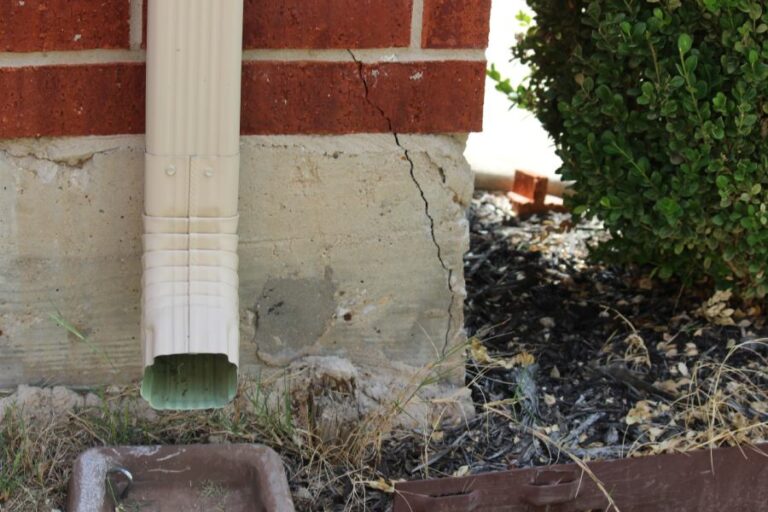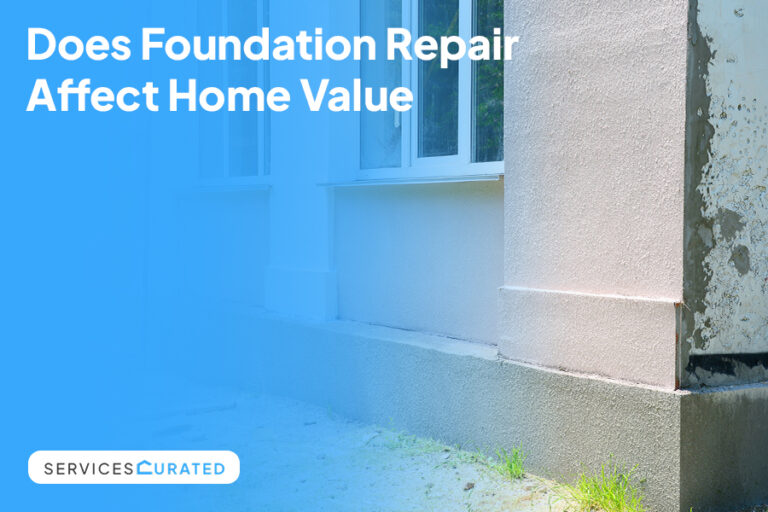Your home’s foundation is the bedrock of its stability and structural integrity. However, various factors can compromise this crucial element over time, leading to potentially serious issues that affect your entire property.
From subtle cracks to more dramatic shifts, foundation problems can manifest in numerous ways, often catching homeowners off guard. Recognizing the signs early and understanding the importance of timely intervention can save you from costly repairs down the line.
In this comprehensive guide, we’ll explore the world of foundation repair, shedding light on common causes, telltale symptoms, and innovative solutions available in today’s market. Whether you’re a new homeowner or have lived in your house for decades, this information is vital for maintaining your property’s value and ensuring your family’s safety.
Join us as we dive into the complexities of foundation repair, empowering you with the knowledge to make timely decisions about your home’s most critical structural component.
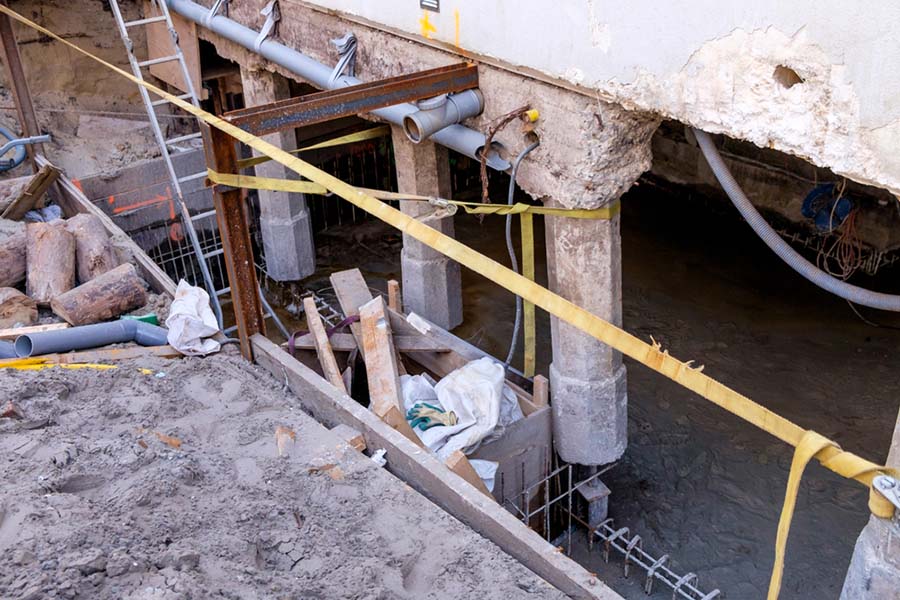
Common Foundation Issues
Cracks in walls and floors
Foundation problems often show up as cracks in your home. You might see vertical cracks in walls, which are common in new homes as they settle. These are usually not serious if they stay small.
But horizontal cracks are more worrying. They can mean serious foundation issues and need quick attention. Floor cracks can also appear. Small ones are often okay, but large or spreading cracks need a professional look.
Uneven or sloping floors
Uneven or sloping floors can indicate foundation problems. Sloping occurs when one part of the house sinks more than another, while bouncy floors suggest weak floor joists, often from moisture damage. Also, check for gaps between floors and walls, as these can expand over time, signaling the need for foundation repairs.
Ignoring these signs can lead to more severe structural damage. Regular inspections by a professional can help identify and address these issues early. Maintaining proper drainage around your home can prevent moisture-related foundation problems.
Doors and windows that stick
When doors and windows become hard to open or close, it might be more than just age. Foundation issues can cause frames to shift, making doors scrape or windows stick. Check if this is happening to several doors or windows, especially on one side of the house. This could mean that part of your foundation is settling.
Look for growing gaps around door and window frames. Sticky doors and windows can indicate uneven floors or structural issues. Addressing these signs early can prevent more extensive and costly repairs later on.
Water damage and moisture issues
Water can cause big problems for foundations. Look for water stains on walls or ceilings. These often look yellow or brown and mean water is getting in somewhere.
Mold growth is another sign of moisture problems. It’s common in damp areas like bathrooms and basements. If you smell a musty odor, especially in the basement or crawl space, it could mean hidden water damage. Always try to find and fix the source of moisture to prevent more damage.
Causes of Foundation Problems
Soil movement
Foundation problems often start with the soil beneath your home. Some soils, especially those rich in clay, expand when wet and shrink when dry. This constant change puts stress on your foundation. As the soil moves, it can create gaps or push against your foundation, causing it to crack or shift.
Erosion is another soil-related issue. When water washes away soil from under your home, it leaves parts of the foundation unsupported. Even the natural settling of soil over time can cause problems, particularly if the ground wasn’t properly prepared before construction.
Poor construction
The way your home’s foundation was built plays a big role in its long-term stability. If the foundation design isn’t suitable for your soil type or climate, problems are likely to occur. Using low-quality materials, like weak concrete or improperly placed reinforcement, can lead to a foundation that’s prone to damage.
Proper site preparation is also crucial. If the ground isn’t leveled correctly or if builders don’t remove all the topsoil before laying the foundation, it can lead to uneven settling and cracks.
Water damage
Water is a major enemy of foundations. Poor drainage around your home can lead to water pooling near the foundation, which can seep into the soil and cause it to expand or erode. Plumbing leaks, especially from sewer lines, can saturate the soil and wash away support from under your foundation.
Major flooding events are particularly damaging. They can cause immediate and severe foundation movement. They weaken the soil’s ability to support a home’s weight.
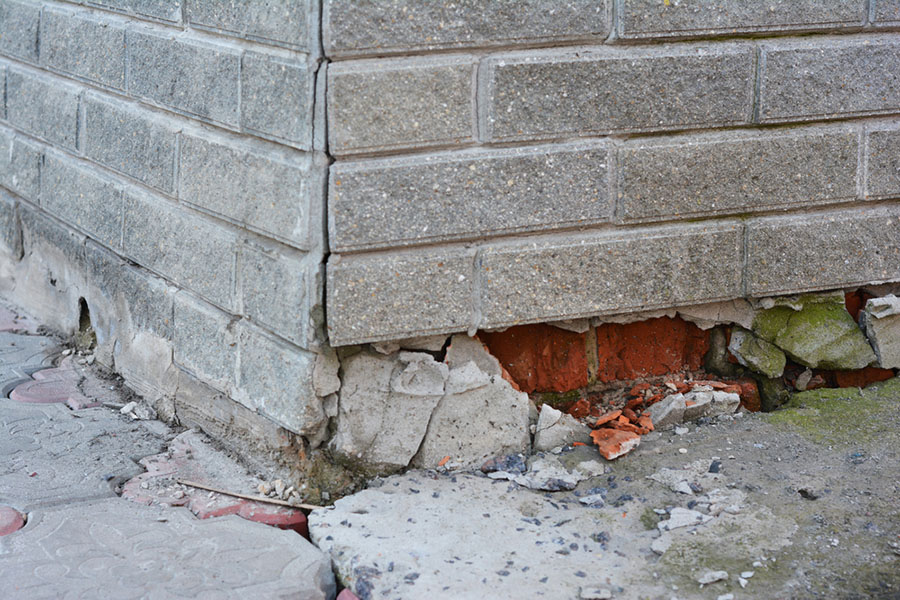
Tree roots
While trees add beauty to your property, their roots can cause foundation problems. Tree roots seek out water, which can dry out the soil near your foundation, causing it to shrink and create gaps.
Large roots can also exert physical pressure on foundation walls, leading to cracks or shifts. In some cases, tree roots can damage underground utilities, causing leaks that further impact the soil around your foundation.
Types of Foundation Repair
Crack repair
When it comes to fixing foundation problems, crack repair is often the first line of defense. For small, non-moving cracks, epoxy injection is a popular choice. This method uses a strong adhesive to fill and seal the crack, preventing water from entering.
For active leaks, hydraulic cement is often used. It expands as it dries, creating a watertight seal that can stop water flow almost immediately. For more serious structural cracks, carbon fiber reinforcement might be necessary. This method uses strong, thin strips of carbon fiber to prevent cracks from widening, providing a nearly invisible but permanent solution.
Piering and underpinning
For more severe foundation issues, especially when a house is sinking, piering and underpinning techniques come into play. Push piers are steel tubes driven deep into the ground until they reach stable soil or bedrock. They can then be used to lift the house back to level.
Helical piers, which look like giant screws, are another option. They’re particularly useful in areas with high water tables or for lighter structures. For very heavy buildings, concrete piers might be necessary. While more disruptive to install, they provide extremely stable support.
Slabjacking
Slabjacking is used to lift and level concrete slabs that have sunk. Traditional mudjacking uses a slurry of soil, cement, and water pumped under the slab to lift it.
A more modern approach is polyurethane foam injection, which uses expanding foam to fill voids and lift the concrete. This method is cleaner and more precise than mudjacking. Grout injection is another option, using a cement-based grout to both lift the slab and stabilize the soil underneath.
Drainage solutions
Many foundation problems are caused by water, so proper drainage is crucial. French drains are trenches filled with gravel and a perforated pipe that redirect water away from the foundation. Sump pumps are installed in basements to remove water that has already gotten in.
Proper grading and landscaping around the house can prevent water from pooling near the foundation. These methods work together to keep your foundation dry and stable.
Waterproofing
Waterproofing can provide an extra layer of protection for your foundation. Interior sealants can be applied inside the basement to create a barrier against minor moisture issues. For more serious problems, exterior waterproofing membranes might be necessary. These create a waterproof barrier on the outside of the foundation but require excavation to install.
Crack injection is a method that seals individual cracks with epoxy or polyurethane foam. This technique can be used in combination with other waterproofing methods for comprehensive protection.
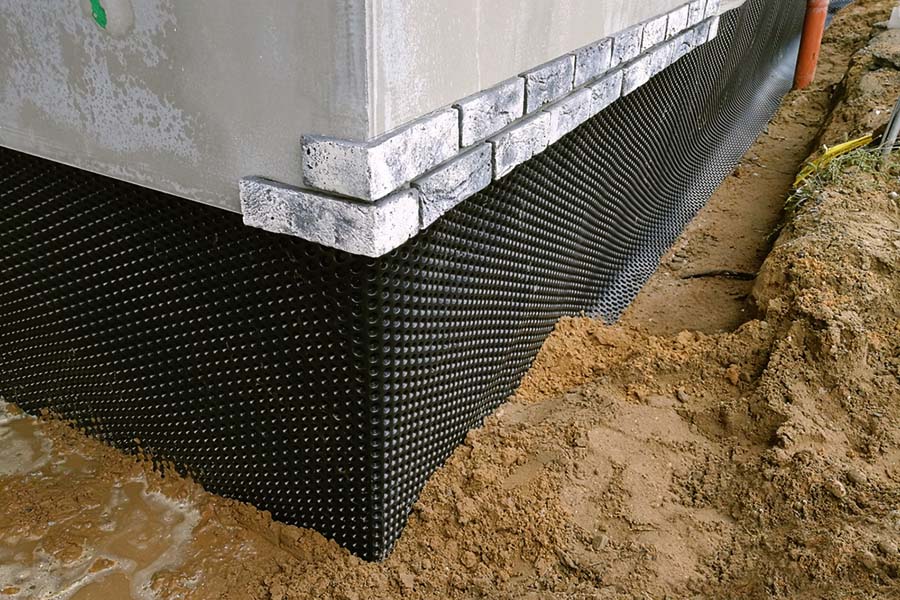
Process of Foundation Repair
1. Initial assessment and inspection
When a foundation problem is suspected, experts start with a thorough check. They look for signs like cracks in walls and uneven floors and use special tools to measure how much the foundation has moved.
The soil around the building is tested too. This helps them understand what’s happening underground. All this information helps figure out how serious the problem is and what to do next.
2. Determining the cause of the problem
After the inspection, it’s time to find out why the foundation is having problems. Sometimes it’s because of the soil. Some soils swell when wet and shrink when dry, which can damage foundations. Poor drainage can also cause issues.
In other cases, the problem might be how the building was made. Mistakes during construction can lead to problems years later, and natural events like earthquakes or floods can also damage foundations.
3. Choosing the appropriate repair method
Once the cause is known, experts choose the best way to fix it. There are several methods. Underpinning makes the foundation deeper and stronger. Piering uses strong supports to hold up the foundation. Grouting fills in empty spaces under the foundation.
The choice depends on what’s wrong and what will work best for that building. Each method has its pros and cons, and the experts consider these carefully. The goal is to ensure the building remains stable and safe for years to come.
4. Implementing the repair
When it’s time to fix the foundation, the area is prepared first. This might mean digging around the building. The repair team follows a careful plan. They work in stages to keep the building safe. They check their work often to make sure it’s done right.
After the main work is done, they clean up the area and try to make it look nice again. This includes restoring landscaping and making any necessary touch-ups. The final step is a thorough inspection to ensure everything is in order. They also provide the building owner with maintenance tips to prevent future issues.
5. Post-repair evaluation and monitoring
As soon as the repair is finished, experts check to make sure it works. They take measurements to see if the foundation is stable now. But the work isn’t over yet. They plan to keep checking the foundation for months or years. This helps catch any new problems early.
The building owner also gets advice on how to take care of the foundation. This includes tips on keeping water away from the building and what to watch for. Regular maintenance checks are scheduled to ensure ongoing stability, the goal is to prevent future damage and ensure the longevity of the repair.
Choosing a Foundation Repair Company
When you need to fix your home’s foundation, picking the right company is very important. There are several key things to think about and questions to ask. This guide will help you make a good choice.
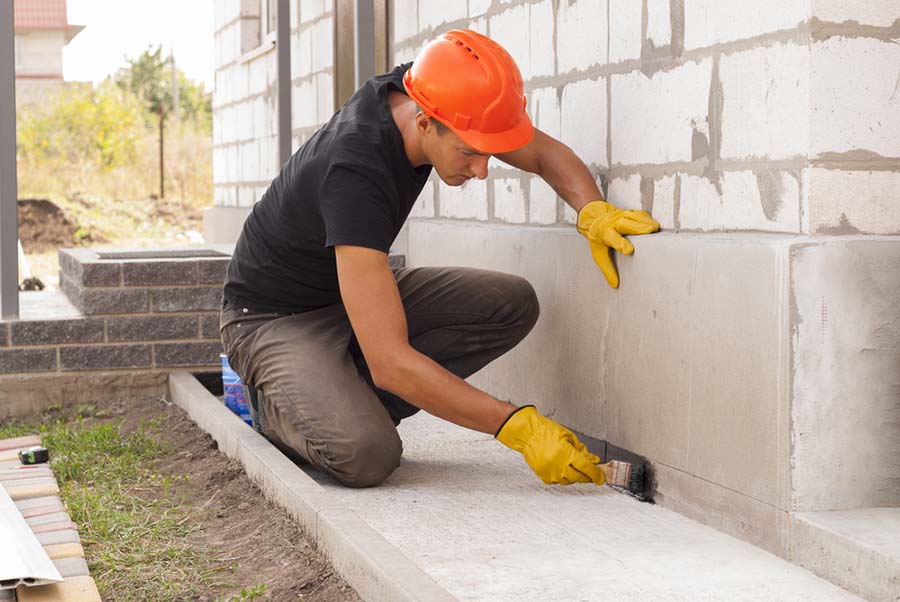
Factors to consider
When choosing a foundation repair company, it’s essential to consider several factors. Verify the company’s licenses and certifications for compliance with local regulations. Experience is crucial; companies with a long history are more adept at diagnosing and fixing various foundation issues.
Assess their response time and availability, especially for emergencies, and ensure they maintain good communication during the repair process. Evaluate the company’s reputation through reviews and testimonials, and request references from recent jobs.
Check their insurance coverage to protect yourself from potential liabilities. Lastly, inquire about the technology and equipment they use, as modern tools and methods often lead to more effective and durable repairs.
Questions to ask potential companies
When selecting a foundation repair company, ask about project specifics, including the timeline, potential issues, and measures to minimize disruption to your property. Clarify the materials used and any required permits.
Obtain a detailed written estimate. Inquire about possible extra charges, payment schedules, and available payment plans. Compare offerings from different companies. Ask about their procedures for ongoing maintenance and follow-up inspections and inquire about how to reach them for future concerns. Ensure they provide strong warranties as well.
Careful consideration and thorough questioning will help you choose a reliable company that ensures a durable repair.
DIY vs. Professional Foundation Repair
When your home’s foundation needs fixing, you might wonder if you can do it yourself or if you should hire experts. This choice depends on how big the problem is and what skills you have. Let’s look at when you might be able to do it yourself, why hiring professionals can be better, and what could go wrong if you try to fix it on your own.
When DIY might be feasible
Sometimes, you can fix small foundation problems yourself. This is usually true for tiny cracks or minor surface issues. If you see very thin cracks, less than 1/8 inch wide, you might be able to fill them with special materials from a hardware store. These small cracks often happen when a house settles naturally.
You can also do some simple things to help your foundation, like making sure water flows away from your house. Adding soil around the foundation or fixing your gutters can prevent some problems. These are easy tasks that don’t need special skills.
Benefits of hiring professionals
Even though DIY can work for small problems, hiring professionals usually yields better results. Foundation repair companies are knowledgeable about different types of foundations and soil.
They can find problems you might not see and know how to fix them the right way. They also have special tools that most homeowners don’t have. These tools let them do bigger repairs, like lifting a sunken foundation.
Professionals can also offer complete solutions. They don’t just fix what you can see, but also deal with what’s causing the problem. This might include fixing drainage issues or making the soil more stable. They also know about building codes and can get any permits you need.
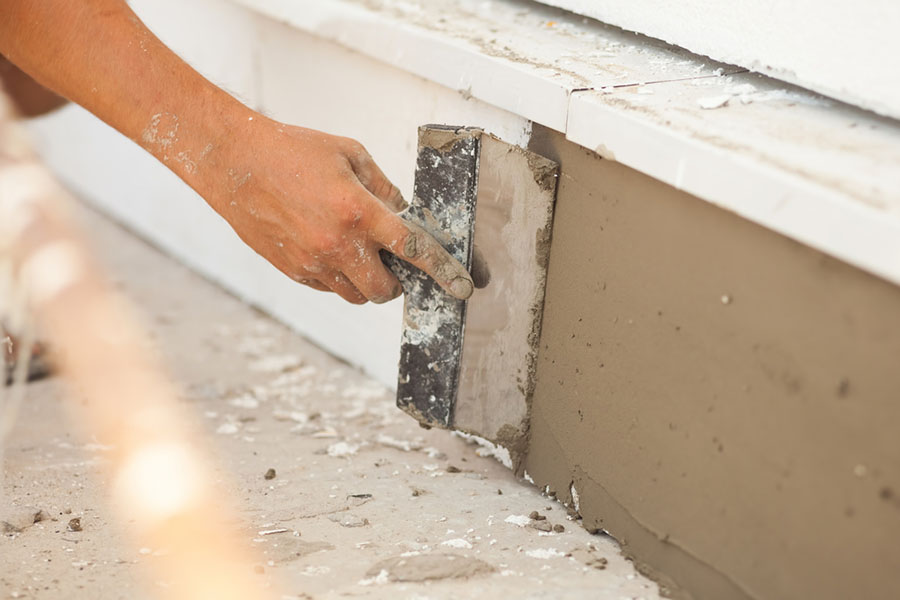
Potential pitfalls of DIY efforts
Trying to fix foundation problems yourself can be risky. You might think a problem is small when it’s actually serious. This could lead to fixing the wrong thing or making the problem worse. DIY repairs might not last long or might not be good enough to really solve the issue.
This can mean you’ll have to spend more money later to fix it properly. There’s also a risk of hurting yourself or damaging your house if you don’t know exactly what you’re doing. Foundation work can be dangerous, especially if you don’t have the right tools or knowledge.
Cost Considerations and Budgeting
Understanding the costs and budgeting is very important when planning for foundation repair. This helps you prepare financially and avoid surprises. Let’s look at the main parts of foundation repair costs, ways to stay within your budget, options for paying, and how to plan for unexpected expenses.
Breaking down costs
Foundation repair costs come from three main areas: materials, labor, and permits. Materials can include concrete, steel piers, or epoxy, depending on your foundation’s needs.
The cost of materials varies based on the repair needed. Labor, often the biggest expense, requires skilled workers to ensure quality. Labor costs depend on the job’s complexity and duration.
Don’t forget about permits and inspections. Many areas require these for foundation work, and they can add to your total cost. It’s important to include all these parts when you’re figuring out your budget.
Tips for staying within budget
To keep your costs under control, start by getting quotes from at least three different contractors. This helps you understand what a fair price is. Make sure to compare what each quote includes. Sometimes, you might need to prioritize repairs if you can’t do everything at once.
Focus on the most important problems first, and also consider timing. Some contractors might offer better prices during their slow seasons. Planning ahead can help you find better deals and give you time to save up.
Financing options and incentives
If you need help paying for repairs, there are several options. Many banks offer home improvement loans, which can help spread out the cost over time. Some areas have government programs that might help, especially for low-income homeowners.
It’s worth checking if your homeowners insurance covers any of the damage. This is usually only for sudden accidents, not gradual damage. Look into all these options to find the best way to pay for your repairs.
Contingency planning for unexpected expenses
It’s smart to plan for surprises when doing foundation work. Try to set aside extra money, about 10-20% more than the estimated cost. This helps cover any unexpected issues that come up during repairs. Talk to your contractor about how they handle surprise costs.
Some might offer flexible payment options. If you’re handy, ask if there are any small tasks you can do yourself to save money. Just be careful not to take on anything too complicated that could cause problems.
Preventing Foundation Problems
Taking care of your home’s foundation is very important. It helps avoid big, expensive problems later. Here are some ways to keep your foundation in good shape. These tips are useful for both homeowners and property managers.
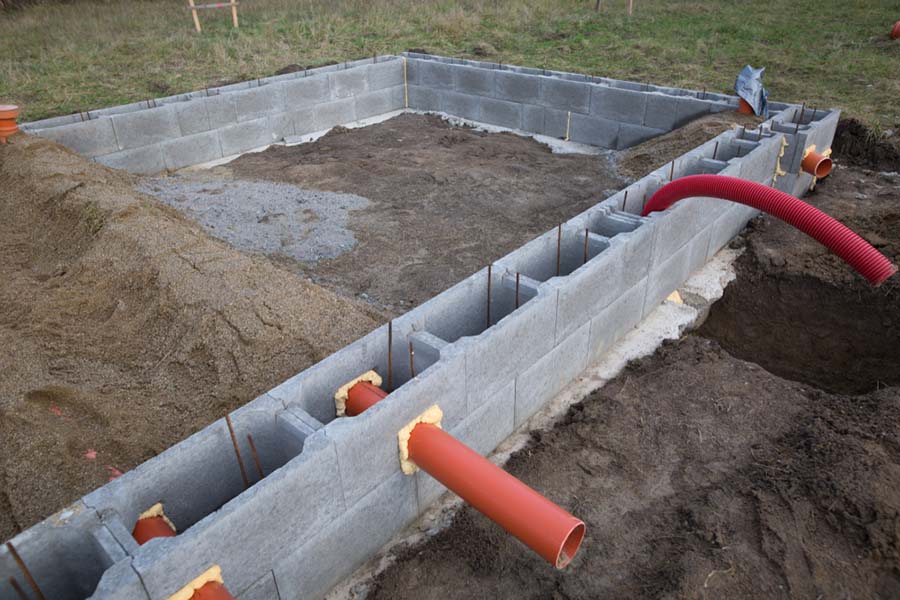
Source: shutterstock.com / Photo Contributor: Simon Kadula
Tips for homeowners and property managers
Regular monitoring
Maintain your home’s structural integrity by conducting regular monitoring. Perform biannual checks for cracks and stay alert for any doors or windows that begin to stick, as these can be early indicators of foundation issues.
Moisture control
Implement effective moisture control measures to protect your foundation. Water the soil around your home during dry periods, but be cautious not to overwater. Ensure proper drainage that directs water away from the house to maintain optimal soil moisture levels and prevent foundation damage.
Landscaping
When landscaping near your foundation, opt for low-water plants and position gardens away from the house. This approach helps maintain consistent soil moisture levels around your foundation, reducing the risk of structural issues.
Maintenance
Perform regular home maintenance to protect your foundation. Keep gutters clean, address roof leaks promptly, and routinely inspect interior walls for cracks. These proactive measures help prevent water damage and catch early signs of foundation problems.
Moisture management
Manage moisture effectively to safeguard your foundation. Address plumbing leaks without delay, employ dehumidifiers in areas prone to dampness, and maintain proper ventilation in basements and crawl spaces. These steps help control moisture levels, preserving your home’s structural integrity.
Quick response
React swiftly to protect your foundation from water damage. Address any water intrusion immediately upon detection, and consider waterproofing your basement or crawl space as a preventive measure. These prompt actions can significantly reduce the risk of foundation issues caused by moisture.
Remember that consistent maintenance of your foundation is key to avoiding costly repairs. Taking preventive measures is both easier and more economical than addressing major problems that develop over time. Regular care and attention to your home’s foundation can save you significant trouble and expense in the long run.
Common Challenges in Foundation Repair
When fixing a home’s foundation, you might face some tricky situations. It’s good to know about these challenges so you can be ready for them. Let’s discuss the main problems you might run into and how to handle them.
Dealing with delays and unexpected issues
Foundation repair doesn’t always go as planned. Weather can be a big problem – rain can stop work, and very hot or cold weather can affect how materials like concrete dry. Sometimes old houses have hidden issues that were not visible before.
Repair work may uncover new problems, such as rotted wood or old pipes. Getting permits can also take longer than expected, slowing down the whole project. It’s important to be patient and flexible when these things happen.
Ensuring proper repair methods
Choosing the right way to fix your foundation is crucial. Different types of foundations and problems require specific solutions, so ensure your contractor explains why they’re using a certain method. It’s also important to use high-quality materials.
While cheap materials might save money initially, they can cause problems later. Ask about the materials that will be used and the reasons for their selection. Even good materials need to be installed correctly. Make sure your contractor knows how to use their equipment properly and follows best practices for installation.
Managing property damage during repair
Fixing a foundation can be messy work. It often involves large machines that can damage your yard or garden, so talk to your contractor about how they’ll protect your landscaping. Inside your house, there might be dust and disruption, and you might need to move furniture or even have holes cut in walls or floors.
Ask how your contractor will minimize this damage and clean up afterward. Foundation work can sometimes affect your utilities, such as water or electricity. Find out if any of these services will need to be turned off during the repair and for how long.
Trends in Foundation Repair
Foundation repair is undergoing a rapid transformation. Innovative techniques and technologies are revolutionizing the industry, making repairs more efficient and effective. Let’s explore the latest trends shaping this critical field of home maintenance.
Current innovations in repair technology
Current innovations in repair technology include the use of smart tools for fixing foundations. Sensors can detect foundation movement, warning homeowners early so problems can be addressed quickly. This saves money and prevents major issues.
Some new repair methods are also environmentally friendly, using materials that don’t harm nature. These green solutions are effective and can increase a home’s value. Modern techniques cause less disruption. Workers can make repairs through small holes, resulting in less digging in yards. This approach is quicker and more cost-effective.
Smart home integration
Homes are getting smarter, and so are their foundations. Special devices now connect foundations to the internet, allowing homeowners to monitor their foundation’s health directly from their phones. By analyzing weather and soil, these devices predict issues before they occur.
Some smart systems even integrate with watering systems, ensuring the soil around foundations remains adequately moist. This prevents excessive ground movement, which can damage foundations.
Popular materials and methods
New materials are making foundations stronger. Special concrete mixes are better at handling water and cracks, lasting longer and requiring fewer repairs. Carbon fiber is another innovative material. It is very strong yet lightweight, helping to keep foundation walls straight and preventing cracks. Many people prefer it because it doesn’t take up much space.
Foam is also becoming popular for lifting sunken foundations. It’s quick to use and works well in many types of soil. These new materials and methods are making foundation repair easier and more effective.
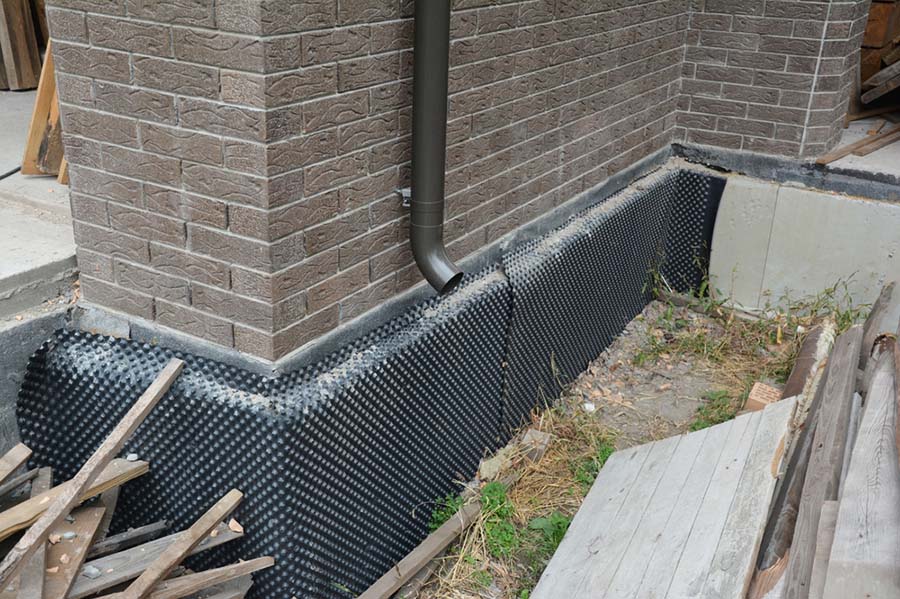
Frequently Asked Questions
How do I know if my house has foundation problems?
Look for these common signs:
- Cracks in walls or floors, especially if they’re wider than 1/8 inch or growing
- Doors and windows that stick or do not close properly
- Uneven or sloping floors
- Gaps around window frames or door frames
If you see several of these signs, it’s best to have a professional inspect your foundation. Not all of these symptoms always mean serious problems, but it’s better to check early than to wait until the issues get worse.
What causes foundation damage?
Foundation damage can have several causes. Soil issues are a common reason – some soils expand when wet and shrink when dry, causing movement under your home. Poor construction can also lead to problems, like using low-quality materials or not preparing the soil properly before building.
Water is another major cause of foundation damage. Too much water near your foundation can erode soil or create pressure against foundation walls. This is why good drainage around your home is so important.
How much does foundation repair typically cost?
The cost of foundation repair varies widely depending on the problem and the repair method needed. Minor repairs might cost a few hundred dollars, while major structural work can run into tens of thousands. For example, filling small cracks is usually less expensive than installing support piers under a sinking foundation.
It’s a good idea to get multiple quotes from reputable companies. Remember, addressing problems early often costs less than waiting until they become severe. While foundation repair can be expensive, it’s an important investment in your home’s safety and value.
Is it true that all foundation cracks indicate serious structural damage?
No, not all foundation cracks are cause for alarm. Small, hairline cracks are often normal settling and don’t necessarily indicate serious structural issues. However, larger cracks, especially those wider than 1/4 inch or that change over time, should be evaluated by a professional.
It’s important to monitor cracks over time and look for other signs of foundation problems, such as doors that won’t close properly or uneven floors.
Does foundation repair always require extensive excavation around my entire home?
This is a common misconception. Many modern foundation repair techniques, such as slab jacking or helical piers, can often be performed with minimal disruption to your landscaping. The extent of excavation needed depends on the specific issue and repair method chosen.
A reputable foundation repair company will assess your specific situation and recommend the least invasive method that will effectively solve the problem. They should also take care to protect your property and minimize any necessary disruption during the repair process.
Locations
California
- Los Angeles
- San Diego
- San Jose
- San Francisco
- Fresno
- Sacramento
- Long Beach
- Oakland
- Bakersfield
- Anaheim
- Santa Ana
- Riverside
- Stockton
- Chula Vista
- Irvine
- Fremont
- San Bernardino
- Modesto
- Fontana
- Oxnard
- Moreno Valley
- Glendale
- Huntington Beach
- Santa Clarita
- Oceanside
- Garden Grove
- Rancho Cucamonga
- Santa Rosa
- Ontario
- Elk Grove
- Corona
- Lancaster
- Palmdale
- Hayward
- Salinas
- Pomona
- Sunnyvale
- Escondido
- Torrance
- Pasadena
- Fullerton
- Orange
- Roseville
- Visalia
- Thousand Oaks
- Concord
- Simi Valley
- Santa Clara
- Victorville
- Vallejo
- Berkeley
- El Monte
- Downey
- Costa Mesa
- Inglewood
- Carlsbad
- Fairfield
- Ventura
- Temecula
- Antioch
- Richmond
- West Covina
- Murrieta
- Norwalk
- Daly City
- Burbank
- Santa Maria
- El Cajon
- San Mateo
- Rialto
- Clovis
- Jurupa Valley
- Compton
- Vista
- Mission Viejo
- South Gate
- Vacaville
- Carson
- Hesperia
- Santa Monica
- Westminster
- Redding
- Santa Barbara
- Chico
- Newport Beach
- San Leandro
- Indio
- Tracy
- Livermore
- Baldwin Park
- Merced
- Chino
- Redwood City
- Lake Forest
- Napa
- Tustin
- Buena Park
- Mountain View
- Lakewood
- San Marcos
Texas
- Houston
- San Antonio
- Dallas
- Austin
- Fort Worth
- El Paso
- Arlington
- Corpus Christi
- Plano
- Laredo
- Lubbock
- Garland
- Irving
- Amarillo
- Grand Prairie
- Brownsville
- McKinney
- Frisco
- Pasadena
- Mesquite
- Killeen
- Carrollton
- Midland
- Waco
- Denton
- Abilene
- Odessa
- Beaumont
- Round Rock
- Richardson
- Pearland
- College Station
- Tyler
- League City
- Wichita Falls
- Allen
- San Angelo
- Edinburg
- Sugar Land
- Mission
- Conroe
- Bryan
- New Braunfels
- Pharr
Florida
- Jacksonville
- Miami
- Tampa
- Orlando
- St. Petersburg
- Hialeah
- Tallahassee
- Port St. Lucie
- Cape Coral
- Fort Lauderdale
- Pembroke Pines
- Hollywood
- Miramar
- Gainesville
- Coral Springs
- Clearwater
- Miami Gardens
- Palm Bay
- Pompano Beach
- West Palm Beach
- Lakeland
- Davie
- Miami Beach
- Plantation
- Sunrise
- Boca Raton
- Deltona
- Palm Coast
- Largo
- Melbourne
New York
- New York City
- Buffalo
- Rochester
- Yonkers
- Syracuse
- Albany
- New Rochelle
- Mount Vernon
- Schenectady
- Utica
- White Plains
- Hempstead
- Troy
- Niagara Falls
- Binghamton
- Freeport
- Valley Stream
- Long Beach
- Rome
- North Tonawanda
Pennsylvania
- Philadelphia
- Pittsburgh
- Allentown
- Erie
- Reading
- Scranton
- Bethlehem
- Lancaster
- Harrisburg
- Altoona
Illionois
- Chicago
- Aurora
- Rockford
- Joliet
- Naperville
- Springfield
- Peoria
- Elgin
- Waukegan
- Champaign
- Bloomington
- Decatur
- Evanston
- Des Plaines
- Berwyn
- Wheaton
- Belleville
Ohio
- Columbus
- Cleveland
- Cincinnati
- Toledo
- Akron
- Dayton
Georgia
- Atlanta
- Augusta
- Columbus
- Savannah
- Athens
North Carolina
- Charlotte
- Raleigh
- Greensboro
- Durham
- Winston-Salem
- Fayetteville
- Cary
- Wilmington
- High Point
Michigan
- Detroit
- Grand Rapids
- Warren
- Sterling Heights
- Ann Arbor
- Lansing
- Flint
- Dearborn
- Livonia
- Troy
New Jersey
- Newark
- Jersey City
- Paterson
- Elizabeth
- Edison
- Woodbridge
- Lakewood
- Toms River
- Hamilton
- Trenton
Virginia
- Virginia Beach
- Norfolk
- Chesapeake
- Richmond
- Newport News
- Alexandria
- Hampton
- Roanoke
- Portsmouth
- Suffolk
Washington
- Seattle
- Spokane
- Tacoma
- Vancouver
- Bellevue
- Kent
- Everett
- Renton
- Federal Way
- Yakima
Massachusetts
- Boston
- Worcester
- Springfield
- Lowell
- Cambridge
- New Bedford
- Brockton
- Quincy
- Lynn
- Fall River
Arizona
- Phoenix
- Tucson
- Mesa
- Chandler
- Glendale
- Scottsdale
- Gilbert
- Tempe
- Peoria
- Surprise
Tennessee
- Nashville
- Memphis
- Knoxville
- Chattanooga
- Clarksville
- Murfreesboro
- Franklin
- Jackson
- Johnson City
- Bartlett
Indiana
- Indianapolis
- Fort Wayne
- Evansville
- South Bend
- Carmel
- Fishers
- Bloomington
- Hammond
- Gary
- Lafayette
Missouri
- Kansas City
- St. Louis
- Springfield
- Columbia
- Independence
- Lee’s Summit
- O’Fallon
- St. Joseph
- St. Charles
- St. Peters
Maryland
- Baltimore
- Columbia
- Germantown
- Silver Spring
- Waldorf
- Glen Burnie
- Ellicott City
- Frederick
- Dundalk
- Rockville
Wisconsin
- Milwaukee
- Madison
- Green Bay
- Kenosha
- Racine
- Appleton
- Waukesha
- Oshkosh
- Eau Claire
- Janesville
Colorado
- Denver
- Colorado Springs
- Aurora
- Fort Collins
- Lakewood
- Thornton
- Arvada
- Westminster
- Pueblo
- Centennial
Minnesota
- Minneapolis
- St. Paul
- Rochester
- Duluth
- Bloomington
- Brooklyn Park
- Plymouth
- St. Cloud
- Eagan
- Woodbury
South Carolina
- Columbia
- Charleston
- North Charleston
- Mount Pleasant
- Rock Hill
- Greenville
- Summerville
- Sumter
- Goose Creek
- Hilton Head Island
Alabama
- Birmingham
- Montgomery
- Mobile
- Huntsville
- Tuscaloosa
Louisiana
- New Orleans
- Baton Rouge
- Shreveport
- Lafayette
- Lake Charles
Kentucky
- Louisville
- Lexington
- Bowling Green
- Owensboro
- Covington
Oregon
- Portland
- Salem
- Eugene
- Gresham
- Hillsboro
Oklahoma
- Oklahoma City
- Tulsa
- Norman
- Broken Arrow
- Edmond
Connecticut
- Bridgeport
- New Haven
- Stamford
- Hartford
- Waterbury
Iowa
- Des Moines
- Cedar Rapids
- Davenport
- Sioux City
- Iowa City
Mississippi
- Jackson
- Gulfport
- Southaven
- Hattiesburg
- Biloxi
Arkansas
- Little Rock
- Fort Smith
- Fayetteville
- Springdale
- Jonesboro
Utah
- Salt Lake City
- West Valley City
- Provo
- West Jordan
- Orem
Nevada
- Las Vegas
- Henderson
- Reno
- North Las Vegas
- Sparks
Kansas
- Wichita
- Overland Park
- Kansas City
- Olathe
- Topeka
New Mexico
- Albuquerque
- Las Cruces
- Rio Rancho
- Santa Fe
- Roswell
Nebraska
- Omaha
- Lincoln
- Bellevue
- Grand Island
- Kearney
West Virginia
- Charleston
- Huntington
- Parkersburg
- Morgantown
- Wheeling
Idaho
- Boise
- Meridian
- Nampa
- Idaho Falls
- Pocatello
Hawaii
- Honolulu
- Pearl City
- Hilo
- Kailua
- Waipahu
Maine
- Portland
- Lewiston
- Bangor
- South Portland
- Auburn
New Hampshire
- Manchester
- Nashua
- Concord
- Derry
- Dover
Rhode Island
- Providence
- Warwick
- Cranston
- Pawtucket
- East Providence
Montana
- Billings
- Missoula
- Great Falls
- Bozeman
- Butte
Delaware
- Wilmington
- Dover
- Newark
- Middletown
- Smyrna
South Dakota
- Sioux Falls
- Rapid City
- Aberdeen
- Brookings
- Watertown
North Dakota
- Fargo
- Bismarck
- Grand Forks
- Minot
- West Fargo
Alaska
- Anchorage
- Fairbanks
Vermont
- Burlington
- South Burlington
Wyoming
- Cheyenne
- Casper
Recent Blog Posts
Types of Underpinning
Underpinning is a critical technique in construction and renovation, essential for reinforcing and stabilizing building foundations. As structures age or…
Does Foundation Repair Affect Home Value?
In the realm of real estate, a home’s foundation is often considered its most crucial component. It’s the literal bedrock…
Does Homeowners Insurance Cover Foundation Repair?
When it comes to protecting your home, homeowners insurance is often seen as a financial safety net. It’s the cushion…

